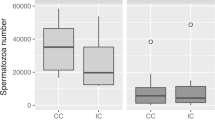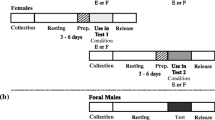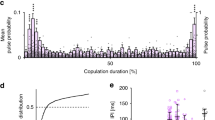Abstract
Copulatory behavior in the octopus consists of a patterned series of movements whose individual functions are not well understood. Observations and experiments on mating in Octopus vulgaris and O. hummelincki from Bimini, Bahamas and Haiti were made over a number of years in the laboratory. The study reveals how the male octopus reverses its spermatophore prior to transferring it to the female. The male’s terminal organ (penis) extrudes the sperm end of the spermatophore as it exits from Needham’s sac up to the cap or filament thread and then, holding onto the cap thread, inserts the ejaculatory end of the spermatophore into the groove of the hectocotylus, thus reversing it. It is hypothesized that the primary function of the cap or filament thread, one part of the spermatophore, is to be a handle by which the reversal and transfer is accomplished. The siphon is merely a conduit through which the terminal organ functions and plays no role whatsoever in either the reversal of the spermatophore or in its insertion into the groove. The stimulus to which the male orients to find the groove of the hectocotylus is the apex of the retracted interbrachial membrane between the third and fourth right arms, which bears a fixed spatial relationship to the origin of the groove. A number of deviations from the successful transfer process, which represent loss of sperm from the reproductive process, are illustrated. Despite these deviations, the delicately balanced integration of the various movements serves to transfer the spermatophore to the female to ensure reproductive success.



Similar content being viewed by others
References
Bone Q, Pulsford AL, Chubb AD (1981) Squid mantle muscle. J Mar Biol Assoc UK 61:327–342
Dew B (1959) Some observations on the development of two Australian octopuses. Proc R Zool Soc N S W 1957(58):44–52
Drew GA (1919) The structure and ejaculation of the spermatophore of Octopus americana. Carnegie Institution of Washington. Pap Tortugas Lab XIV:33–47
Hanlon RT, Messenger JB (1996) Cephalopod behaviour. Cambridge University Press, London, pp 1–232
Hanson D, Mann T, Martin AW (1973) Mechanism of the spermatophoric reaction in the giant octopus of the North Pacific, Octopus dofleini martini. J Exp Biol 58:711–723
Mann T (1984) Spermatophores: Development, structure, biochemical attributes, and role in the transfer of spermatozoa. Springer, Berlin, pp 1–217
Mann T, Martin AW, Thiersch JB (1966) Spermatophores and spermatophoric reaction in the giant octopus of the North Pacific, Octopus dofleini martini. Nature 211:1279–1282. doi:10.1038/2111279a0
Mann T, Martin AW, Thiersch JB (1970) Male reproductive tract, spermatophores and spermatophoric reaction in the giant octopus of the North Pacific, Octopus dofleini martini. Proc R Soc Lond B Biol Sci 175:31–61
Needham J (1745) New microscopical discoveries. F Needham, London
Packard A, Trueman ER (1974) Muscular activity of the mantle of Sepia and Loligo (Cephalopoda) during respiratory movements and jetting, and its physiological interpretation. J Exp Biol 61:411–419
Racovitza EG (1894) Notes de biologie. I Accouplement et fécondation chez l’Octopus vulgaris Lam. Arch Zool Exp Gen 2:23–49
Steenstrup J (1856) Die Hectocotylenbildung bei den Cephalopoden. Archival Naturegesch 22, 211–257 Translated in 1857. Hectocotylus-formation in Argonauta and Tremoctopus explained by observation on similar formations in the Cephalopoda in general. Ann Mag Nat Hist 20:81–116
Swammerdam J (1737) Biblia Naturae. Leyden: Isaack Severinus, Boubowyn Vander and Peter Vander. Translated in 1758 The Book of Nature CG Seyffert, London
Verrill AB (1882) The Cephalopods of the north-eastern coast of America. Part II: the smaller cephalopods, including the “squids” and the octopi, with other allied forms. Trans Conn Acad Arts Sci V:259–446
Voight JR (2002) Morphometric analysis of male reproductive features of Octopodids (Mollusca: Cephalopoda). Biol Bull 202:148–155. doi:10.2307/1543651
von Orelli M (1962) Die Ubertragung der spermatophore von Octopus and Eledone (Cephalopoda). Rev Suisse Zool 69:93–102
Ward DV (1972) Locomotory function of the squid mantle. J Zool 167:487–499
Ward DV, Wainwright SA (1972) Locomotory aspects of squid muscle structure. J Zool 167:437–449
Wells MJ, Wells J (1972) Sexual displays and mating of Octopus vulgaris Cuvier and O. cyanea Gray and attempts to alter performances by manipulating the glandular condition of the animals. Anim Behav 20:293–308. doi:10.1016/S0003-3472(72)80051-4
Wodinsky J (1972) Breeding season of Octopus vulgaris. Mar Biol (Berl) 16:59–63. doi:10.1007/BF00347848
Wodinsky J (1973) Ventilation rate and copulation in Octopus vulgaris. Mar Biol (Berl) 20:154–164. doi:10.1007/BF00351454
Wolterding MR (1971) The rearing and maintenance of Octopus briareus in the laboratory, with aspects of their behaviour and biology. MA Thesis, University of Miami
Acknowledgments
I gratefully thank Joel Cohen, Jean Fraser, Barbara Gruenthal, Mark Jacquin, David Lewkowitz, Jennifer Mather, Nancy Sack, Gayle Schectman, David Segal, Nedra Shulkin, and Dr. James Goldberg for assistance in various phases of this research. I thank the New England aquarium for its generous supply of filtered seawater. I thank Harvey Wang for Figures 1, 2, and 3. I thank Drs. Philip Zeigler and Peter Moller for their helpful comments on the manuscript. I thank Keren Klein and Phil Gnatowski for preparation of the manuscript. I also thank the reviewers of Marine Biology for their detailed, helpful comments on the manuscript.
Author information
Authors and Affiliations
Corresponding author
Additional information
Communicated by J.P. Grassle.
Appendices
Appendix 1
Experiment 2 for O. vulgaris (including Number of Tests, Number of Tests with no A and Ps, Number of A and Ps, Duration of Tests)
(a) First cut | ||||||||||
|---|---|---|---|---|---|---|---|---|---|---|
Subject | Days | Number of tests | Number of tests with no As and Ps | Test duration (min) | Number of As and Ps | |||||
Cut | R | Cut | R | Cut | R | Cut | R | Cut | R | |
8 | 1–23 | 9 | 2 | 77 | 27 | |||||
24–37 | 5 | 0 | 91 | 38 | ||||||
4 | 1–26 | 11 | 5 | 66 | 9 | |||||
27–36 | 4 | 0 | 76 | 47 | ||||||
12 | 1–24 | 10 | 6 | 61 | 10 | |||||
25–38 | 5 | 0 | 88 | 54 | ||||||
20 | 1–26 | 11 | 11 | 74 | 0 | |||||
27–36 | 4 | 0 | 90 | 68 | ||||||
Total | 41 | 18 | 23 | 0 | \( \overline x \) = 69.5 | \( \overline x \) = 86.2 | 46 | 207 | ||
(b) second cut | ||||||||||
|---|---|---|---|---|---|---|---|---|---|---|
Subject | Days | Number of tests | Test duration (min) | Number of As and Ps | Number of tests with no As and Ps | |||||
8 | 17 | 6 | 73 | 27 | 2 | |||||
4 | 17 | 6 | 88 | 0 | 6 | |||||
12 | 16 | 6 | 88 | 8 | 2 | |||||
20 | 16 | 6 | 101 | 2 | 4 | |||||
Total | 24 | \( \overline x \) = 87.5 | 37 | 14 | ||||||
Appendix 2
Latencies to first Arch and Pump for O. vulgaris in Experiment 2 (min)
Day 1–24 | Day 26–38 | Day 1–17 (2nd Cut) | |
|---|---|---|---|
Mean (SD) | 39.62 (25.08) | 23.17 (19.87) | 39.8 (33.08) |
n | 17 | 19 | 11 |
Range | 6.25–85.5 | 1.38–58.49 | 5.37–97.03 |
Appendix 3
Latencies (min) for O. hummelincki number 21 in Experiment 4 (Tear in the interbrachial membrane)
Test numbers | Number of A and P | Mean latency to 1st A and P (SD) | Observation of spermatophore |
|---|---|---|---|
1–9 | 134 | 6.12 (4.65) | All seen |
10–19 | 137 | 12.35 (15.73) | Some seen |
20–32 | 112 | 22.38 (17.22) | None seen |
Appendix 4
Latencies in Experiment 4 for O. hummelincki) pre- and post-surgery on interbrachial membrane (Time in min)
Measure | Subject | |||||
|---|---|---|---|---|---|---|
Number 3 pre-surgery | Number 3 post-surgery | Number 4 pre-surgery | Number 4 post-surgery | Number 16 pre-surgery | Number 16 post surgery | |
Number of tests | 21 | 3 | 18 | 21 | 30 | 21 |
Mean days between tests | 2.7 | 3 | 2.8 | 2.8 | 2.7 | 4.7 |
Total number of A and P’s | 222 | 0 | 150 | 170 | 275 | 88 |
Mean latency to 1st A and P (SD) | 11.92 (8.33) | 12.33 (11.55) | 9.92 (6.93) | 31.87 (18.12) | ||
Tests with no A and Ps | 5 | 3 | 3 | 4 | 7 | 11 |
Appendix 5
Spermatophoric ejaculatory times for O. hummelincki (Mean 69.0 ± 22.13 s; n = 238). 
Rights and permissions
About this article
Cite this article
Wodinsky, J. Reversal and transfer of spermatophores by Octopus vulgaris and O. hummelincki . Mar Biol 155, 91–103 (2008). https://doi.org/10.1007/s00227-008-1010-3
Received:
Accepted:
Published:
Issue Date:
DOI: https://doi.org/10.1007/s00227-008-1010-3




